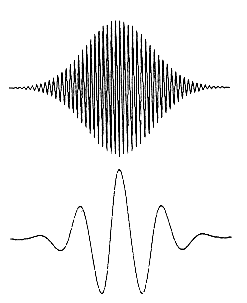|
|
The property of a SOUND OBJECT whose INTERNAL DYNAMICS have a regular, modulatory quality (see MODULATION), as opposed to irregular TRANSIENTs. The term was introduced by Pierre Schaeffer as part of a TYPOLOGY of the sound object. The emphasis therefore is on grain as a perceptual or psychoacoustic variable.
Grain is related to the texture of a sound, and includes such modulations as VIBRATO and TREMOLO, continuous or discontinuous repetitions, as in drum beats, or drawing a stick across an irregular surface.
Compare: BEATS, DRONE, MASS, PULSE, RUSTLE NOISE, STATIONARY SOUND, STOCHASTIC PROCESS, TIMBRE.
![]() Sound
Example: Guiro.
Sound
Example: Guiro.
Sound Example: Chilean rain stick.Sound Example: Carding wool.
A grain is also an elementary acoustic particle or 'quantum' in that it cannot be perceptually subdivided into smaller units (see LAW OF UNCERTAINTY). Its duration is normally less than 50 ms such that sequences of grains fuse perceptually into a continuous sound whose components are not separately identifiable.

Sine wave grains with a Gaussian envelope, the top example having a high frequency waveform, the lower example having a low frequency waveform, but both with the same duration.
In contrast with FOURIER SYNTHESIS which is based on SINE WAVE components with slowly changing amplitudes, granular synthesis is based on enveloped grains, usually deployed in high densities of hundreds or thousands of grains per second. The WAVEFORM of such grains may be synthetic (e.g. sine waves) or derived from environmental sounds. In the latter case, the technique is called granulation.
Compare: SOUND SYNTHESIS, SOUND SYNTHESIZER, TEMPOPHONE.
![]() Sound
Example: Granular synthesis texture
with increasing bandwidth of the frequency of the component
grains.
Sound
Example: Granular synthesis texture
with increasing bandwidth of the frequency of the component
grains.
Sound Example: Granulation of three ferry horn blasts (original sound), with time stretching of the third event to 20 times its normal length.
home